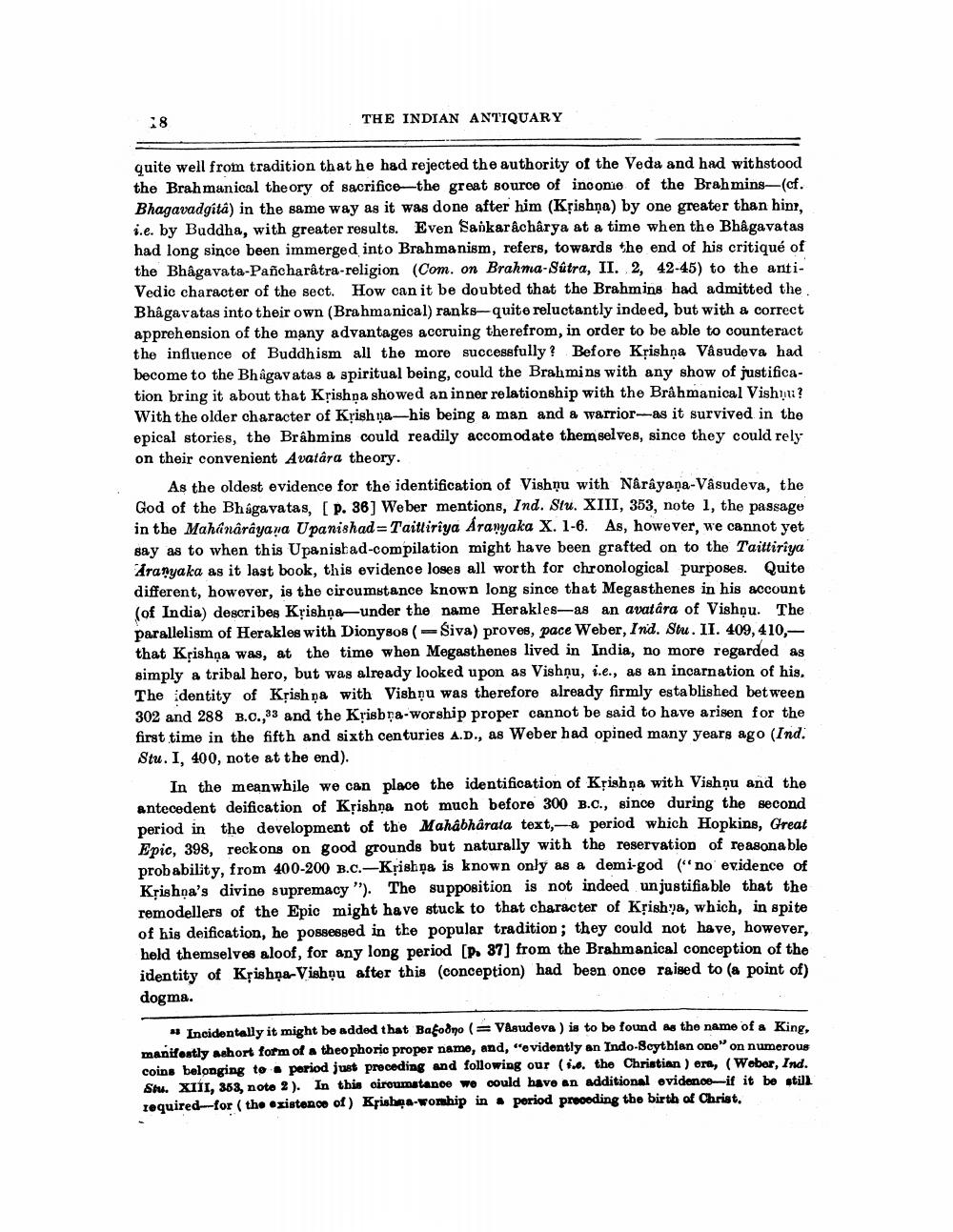________________
18
THE INDIAN ANTIQUARY
quite well from tradition that he had rejected the authority of the Veda and had withstood the Brah manical theory of sacrifice the great source of inoone of the Brahmins-(cf. Bhagavadgita) in the same way as it was done after him (Kộishna) by one greater than hinr, i.e. by Buddha, with greater results. Even Sankaracharya at a time when the Bhagavatas had long since been immerged into Brahmanism, refers, towards the end of his critique of the Bhagavata-Pancharatra-religion (Com. on Brahma-Sútra, II. 2, 42-45) to the antiVedic character of the sect. How can it be doubted that the Brahmins had admitted the Bhagavatas into their own (Brahmanical) ranks quite reluctantly indeed, but with a correct apprehension of the many advantages accruing therefrom, in order to be able to counteract the influence of Buddhism all the more successfully? Before Krishna Vasudeva had become to the Bhagavatas a spiritual being, could the Brahmins with any show of justification bring it about that Krishna showed an inner relationship with the Brahmanical Vishnu? With the older character of Krishna-his being a man and a warrior--as it survived in the epical stories, the Brábmins could readily accomodate themselves, since they could rely on their convenient Avatára theory.
As the oldest evidence for the identification of Vishnu with Narayana-Vasudeva, the God of the Bhagavatas, (p. 36) Weber mentions, Ind. Stu. XIII, 353, note 1, the passage in the Mahanarayana Upanishad=Taitliriya Aranyaka X. 1-6. As, however, we cannot yet say as to when this Upanistad-compilation might have been grafted on to the Taittiriya Aranyaka as it last book, this evidence loses all worth for chronological purposes. Quite different, however, is the circumstance known long since that Megasthenes in his account (of India) describes Krishņa—under the name Herakles--as an avatára of Vishịu. The parallelism of Herakles with Dionysos ( Siva) proves, pace Weber, Ind. Stu. II. 409, 410,that Krishộa was, at the time when Megasthenes lived in India, no more regarded as simply a tribal hero, but was already looked upon as Vishnu, i.e., as an incarnation of his. The identity of Krishna with Vishnu was therefore already firmly established between 302 and 288 B.O.,33 and the Krisbra-worship proper cannot be said to have arisen for the first time in the fifth and sixth centuries A.D., as Weber had opined many years ago (Ind. Stu. I, 400, note at the end).
In the meanwhile we can place the identification of Krishna with Vishņu and the antecedent deification of Krishna not much before 300 B.C., since during the second period in the development of the Mahabharata text,-a period which Hopkins, Great Epic, 398, reckons on good grounds but naturally with the reservation of reasonable probability, from 400-200 B.C.-Krishịa is known only as a demi-god (“no evidence of Krishna's divine supremacy ”). The supposition is not indeed un justifiable that the remodellers of the Epic might have stuck to that character of Kộisha, which, in spite of his deification, he possessed in the popular tradition; they could not have, however, held themselves aloof, for any long period (P. 87] from the Brahmanical conception of the identity of Krishņa-Vishņu after this conception) had been once raised to (a point of) dogma.
Incidentally it might be added that Bafodno (= Vasudeva ) is to be found as the name of a King, manifestly ashort form of a theo phoric proper name, and, "evidently an Indo-Scythian one" on numerous coins belonging to . period just preceding and following our (ie the Christian ) era, (Wobor, Ind. Stu. XIII, 363, noto 2). In this ciroumatanoe we could have an additional ovidence--if it be still required--for ( the existence of) Krishna-womhip in period preceding the birth of Christ.




